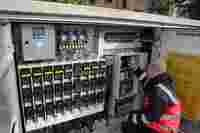Distribution Network in Real Time


The measurement data all originates in a small smart grid, located in the Wüste district of Osnabrück. SWO Netz operated an intelligent network here as a pilot project from 2013 to 2016. “We wanted to use modern technologies to explore how we can manage the addition of decentralized energy producers, like PV arrays, and additional consumers, like eVehicles, in the network. At the same time, we wanted to keep network expansion costs in check,” explains Drecksträter. The project encompassed 60 buildings with 125 apartments. One peculiarity is that seven PV systems produce electricity in this small area. Drecksträter explains, “A decisive criterion for the selection was that, in terms of the the load profile, was transferable to about 90 % of the Osnabrück supply area.” With only a few deviations, the load profile in the area matches the German average. Electrical consumption increases rapidly in the morning, levels off to a moderate level during the day, rises to another peak in the evening and then drops off overnight.
The data about consumers and producers, as well as other relevant values, like active and reactive power in the project area, are collected at a local network station and five cable distribution cabinets that were equipped for intelligence using WAGO components. In addition, one resident who agreed to participate allowed his PV array to be fitted with measurement devices. At the core of the automation is a 750 Series Ethernet I/O Controller (750-880), combined with 3-Phase Power Measurement Modules (750-494) and 855 Series Current Transformers. In all, the components detect more than 215 measured values.
Shortly before the end of the smart grid project, in Fall 2016, a suggestion was made from Minden to evaluate more than just a fraction of the data. Instead, all of the data could be utilized in a targeted way through a cloud application. “The potential for tracking load data and other variables virtually in real time and for analyzing it in depth was certainly enticing,” states Ulrich Clausmeyer, Grid Control Manager at SWO Netz. The Osnabrück utility implemented the cloud connection using WAGO’s Engineering Software. They rely on the PFC200 Controller (750-8207/025/001) with an integrated VPN modem as their controller. The software reflects all physically present components of the smart grid one-to-one. These include the WAGO components installed in the local network station and in the distribution cabinets, which are represented in the user interface. A mouse-click on an individual component opens lists with current measurement values, which the software can then convert into graphs. In addition to the measurement values from the intelligent network components, the utility also receives detailed information from one of the PV systems. “We can thus link specific output values to the weather data,” explains Drecksträter.

The cloud system provides more than just a real-time view of the network status – it also enables new types of analysis. The results provided by the data analysis sometimes confirmed expectations; however, there were also some surprises. “We never had a critical state at any time,” states Drecksträter. However, there were unusual load distributions that only became clear using the visualization provided by the WAGO tool. “We actually had the situation that the PV systems supplied not only consumers in the project area during high production, but also houses in an adjacent network area that lies behind the smart local network station. In the same time period, no network power was used by these consumers; they were completely supplied by the PV systems,” explains Christian Drecksträter. In another case, WAGO’s 3-Phase Power Measurement Module transmitted some surprising news. “While the PV systems were supplying electricity over two phases into the network, they were drawing power down over the third phase,” reports Ulrich Clausmeyer. While the network control center manager had felt in his bones that this might be the case, this was the first actual proof of the fact.
The measurement values are also useful for everyday work in the network control center; however, not all of them are necessary. “The small project area provided a manageable amount of data, which was optimal for analysis. However, we don’t want to use every individual measurement value in our control system, simply because they are not necessary for grid control,” according to Ulrich Clausmeyer. A total of 215 measurement values from the smart grid are filtered in the cloud and aggregated into 41 values. Certain limit values are defined, and the system signals when they are exceeded. In technical terms, the cloud system runs in parallel to the control system. Access security is the reason for this. “Because these are two completely independent systems, hackers are prevented from penetrating the control system from the cloud,” explains Clausmeyer. The cloud system is also not easy for data thieves to crack. Protection is through Security by Design – cybersecurity in the form of a layer-based security architecture that is integrated from the outset into the Linux®-based controllers from WAGO. Communication is secured using the proven MQTT protocol over an encrypted VPN connection.
After their first few experiences with smart grids and cloud systems, the Osnabrück utility subsidiary planned a new project in a larger area. According to Christian Drecksträter, “It is important that we think through current developments and the steps that follow, and then employ technologies that enable us to remain flexible in network planning over the long term.” Ultimately, no one today can definitively state how many decentralized power generating stations or eVehicles will need to be linked to the network in 20 years. Therefore, Osnabrück needs a network that is not only reliable and ready for the future, but can also adapt flexibly to developments.
Background: SWO Netz GmbH
SWO Netz, a wholly owned subsidiary of the Osnabrück municipal utility, is responsible for design, construction and operation of the infrastructure networks in the municipality. The areas of activity include electricity, gas, water, wastewater, telecommunications and street lighting. As one of the first network operators in Germany, SWO Netz was certified by TÜV Rheinland according to the IT security catalog.
Text: Daniel Wiese
Photo: SWO Netz GmbH, Jens Sundheim